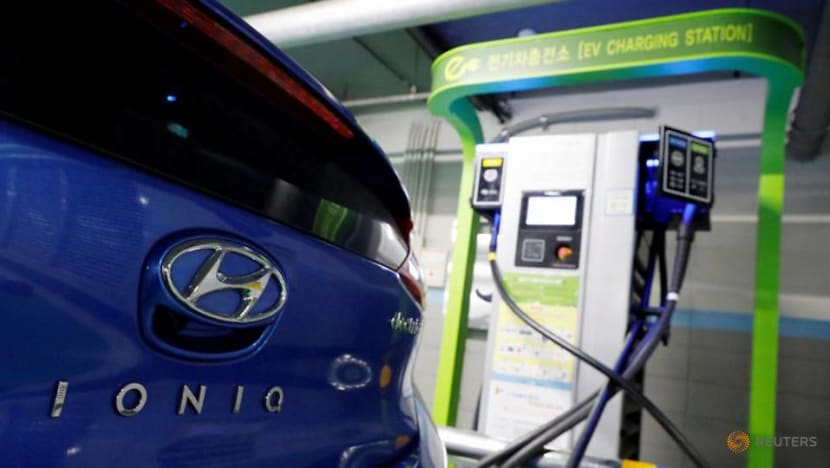commentary Commentary
Commentary: Electric vehicles in Singapore – how much is just hype?
The march towards greater electrification of Singapore’s transport has gathered speed with big plans in the pipeline, argues Sanjay Kuttan.

FILE PHOTO: Tesla Model X electric cars recharge their batteries in Berlin, Germany, November 13, 2019. REUTERS/Fabrizio Bensch/File Photo
SINGAPORE: If you asked anyone which company is the biggest automaker in the world by market value today, you may get the usual answers – Volkswagen, BMW and Toyota Group.
The answer, according to Bloomberg, is Tesla. Owned by the eccentric Elon Musk, Tesla has rewarded its shareholders for their patience – its stock price has risen seven-fold over the last year.
READ: Commentary: Don’t be too quick to write off Elon Musk
While Tesla might be some sort of a unicorn in the electric vehicle (EV) market, there are signs that this is an area to watch.
Chinese companies are also reaping rewards in this area. Start-up Nio’s shares have tripled since its 2018 listing on the New York Stock Exchange.
Two Chinese companies also made blockbuster listings this year. Li Auto debuted on the Nasdaq in July with a US$1.1 billion (S$1.47 billion) initial public offering (IPO), and its shares have grown more than 50 per cent since.
Xpeng made its US entry later in August, after raising US$1.5 billion for its IPO.
READ: China's electric vehicle start-ups race for leading position
Will investors’ fervour for EVs pay off, or is it a bubble waiting to burst?
BUILDING THE ECOSYSTEM FOR ELECTRIFICATION
Changes in the transportation landscape abroad and at home suggest that this is no bubble.

Singapore, as a global financial hub, has jumped into the fray in a big, bold way. We are marching towards greater electrification of our transport sector by declaring we will phase out internal combustion engine vehicles by 2040.
That’s the majority of cars on the road right now. The aim is to drastically increase the number of electric vehicles (EVs) from the current 1,120.
READ: MOT may review 2040 target for all vehicles in Singapore to be low emission: Ong Ye Kung
Our public train system, the MRT is fully electrified, public buses are already heading the same way with the recent tender from the Land Transport Authority (LTA) and the new Tuas mega port will be highly electrified.
We also foresee our harbour craft community on the brink of an electric future with the recent call for commercially-ready proposals by Maritime and Port Authority of Singapore and the Singapore Maritime Institute.
READ: Commentary: Singapore ports and ships are turning the tide on climate change
In the electric vehicles space, 28,000 electric vehicle charging infrastructure will be strategically distributed across our island.
Right now, GreenLots (Shell), SP Group, Blue SG and Red Dot Power are in the market to support car traders importing electric and plugin electric hybrid vehicles.
Sales are enabled by financial incentives of up to S$45,000 that favour the purchase of greener cars under the vehicle emission scheme (VES) and early adoption incentives (EEAI) starting in Jan 2021.

This exciting changing landscape emboldened Hyundai to announce their plans to manufacture electric vehicles in Singapore thus creating greater access to electric vehicles and create jobs for Singapore residents.
BRINGING THE BUBBLE BACK DOWN TO EARTH
While this march towards electrification picks up pace, the question remains if drivers will actually buy EVs, transforming investors’ hopes into reality.
A few more things need to happen before consumers start choosing EVs over traditional cars.
READ: Commentary: What will it take to make Singapore truly car-lite?
First, we need a dedicated certificate of entitlement (COE) category for EVs and plug-in hybrid vehicles. This will help EV charging infrastructure companies time their infrastructure deployment, and car traders pace their sales and availability of models.
If this review happens, then the pulse of the transformation can be felt directly from the uptake of COEs in this category.
READ: Commentary: Will COVID-19 dim Singapore’s love affair with cars?
Second, charging EVs needs to be made fuss-free. Unlike petrol stations which are brightly lit with prominent logos and a history of patronage, locating EV charging stations is a completely different experience.
Right now, the EV charging infrastructure tends to be “hidden” in building carparks, multi-storey carparks or open-air carparks. If you don’t have the app for the charging provider handy, you won’t naturally find it.
So, signage to facilitate routing will make it easier to locate these charging points.
The other issue is that each charging infrastructure provider has their own app, which means you need to open multiple apps to figure out where the chargers are in the carpark, if there are any.

Here, a single integrated platform that allows access to all providers with their own business model still intact will make life easier for the consumer. GovTech could create one as an independent neutral body for the apps from commercial entities to sit on.
Furthermore, if WAZE or Google Maps can upload these sites on to their onboard map systems, it would be a most welcomed feature. With easy access, the high usage of charging units will generate more revenue for the infrastructure companies, further enabling their expansion plans.
CHANGING THE CAR MARKET
The final piece in the jigsaw puzzle of turning EV hype into real gains is the consumer.
In Singapore, not everyone can afford a car, let alone an electric car. But BlueSG has made it possible for Singaporeans to access a car which is fully electric.
READ: Commentary: People love walking and cycling. So why aren't more ditching their cars?
In general, car ownership is a hefty investment. If it is driven by necessity then, design, reliability and range are key decision factors.
Taxis and private hire vehicles are workhorses in our transportation landscape, travelling almost 350 km per shift on average. These “taxi” EVs from BYD and Hyundai Kona and Ioniq demonstrate that range anxiety should not be an issue in Singapore.
If they can manage this, the ordinary driver who averages 40km to 50km per day can be well assured that there is sufficient range before a full charge (depending on the model’s battery size), or opportunistic top-ups (short charging time) that can keep the battery in a high state of charge.
READ: In The New Map, author Daniel Yergin takes on energy, climate change and the slow but sure shifts in big power relationships
Nissan Leaf 2, Renault Fluence, BMWi3, Mini, Mitsubishi models are already available in Singapore with different designs, features and price points to entice a range of consumers.
However, if performance and style are the deciding factors, then models from Tesla, BMW, Audi, Porsche, Jaguar, Mercedes, and the likes will satisfy the senses.

Furthermore, carbon credits generated from the EV ecosystem can be traded, as we have done with solar installations, which creates more value for EV operators and the charging infrastructure provider.
CUSTOMERS HAVE TO SWITCH TO MOVE THE NEEDLE
We are definitely spoilt for choice. If car traders can make a decent profit from the sale, I am sure they will be clamouring from their principle the right to “chope” the available stocks coming out of the production line.
I believe the tipping point will be the battery warranty. When that period coincides with the 10-year COE, the risks associated with batteries - the most costly component - will shift to the car-maker and consumers will start diving in.
Today, depending on the model, the battery life can be anything from six to eight years. But time, experience and technological advances could extend it further.
READ: Commentary: Electric vehicles will take over Singapore. But here’s what must happen first
READ: What’s it like to have an electric car in Singapore? We took the new MINI Electric for a spin
For most of our transportation needs, if the regular use of environmentally friendly public transport doesn’t meet our life needs, then there are options from car-sharing to leasing to ownership of an EV.
While incentives, policy and infrastructure are a job for the government and car companies, the demand for the greening of all goods and services truly lies in the hands of the consumer.
If we choose to drive electric modes of transport even if they are a little more inconvenient, then we can truly move the needle and not only meet our bold electrification plans, but show the rest of Asia how it can be done well.
Listen to Pulitzer prize-winning author Dan Yergin reveal China's calculations with going green and embracing electric vehicles on The Climate Conversations podcast:
Sanjay Kuttan is Chair, Sustainable Infrastructure Committee of the Sustainable Energy Association of Singapore.















